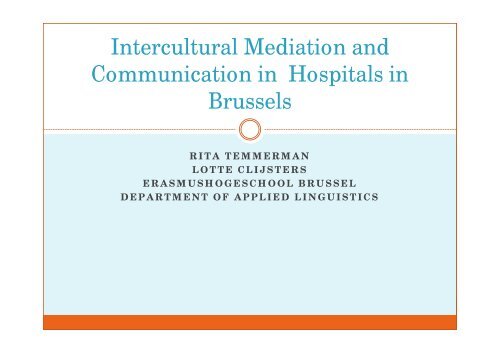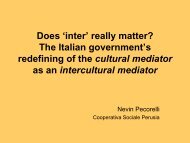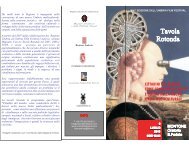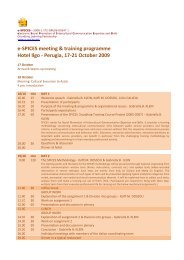Intercultural Mediation and Communication in Hospitals ... - e-SPICES
Intercultural Mediation and Communication in Hospitals ... - e-SPICES
Intercultural Mediation and Communication in Hospitals ... - e-SPICES
You also want an ePaper? Increase the reach of your titles
YUMPU automatically turns print PDFs into web optimized ePapers that Google loves.
<strong>Intercultural</strong> <strong>Mediation</strong> <strong>and</strong><br />
<strong>Communication</strong> <strong>in</strong> <strong>Hospitals</strong> <strong>in</strong><br />
Brussels<br />
RITA TEMMERMAN<br />
LOTTE CLIJSTERS<br />
ERASMUSHOGESCHOOL BRUSSEL<br />
DEPARTMENT OF APPLIED LINGUISTICS
<strong>Intercultural</strong> mediation <strong>and</strong> communication<br />
<strong>in</strong> hospitals <strong>in</strong> Brussels<br />
1. <strong>Intercultural</strong> lmediator<br />
2. Why <strong>in</strong>tercultural mediation<br />
3. History <strong>in</strong>tercultural mediation <strong>in</strong> Belgium<br />
4. <strong>Intercultural</strong> lmediation i <strong>in</strong> Brussels<br />
5. Tra<strong>in</strong><strong>in</strong>g <strong>in</strong>tercultural mediators<br />
6. Research <strong>in</strong> three hospitals
<strong>Intercultural</strong> mediation <strong>and</strong> communication<br />
<strong>in</strong> hospitals <strong>in</strong> Brussels<br />
7. Brugmann Hospital<br />
8. UZ Brussel<br />
9. S<strong>in</strong>t-Pieters Hospital<br />
10. Patient’s own <strong>in</strong>terpreter<br />
11. Turkish women <strong>and</strong> pregnancy<br />
consultation<br />
12. Conclusion
1. <strong>Intercultural</strong> mediator<br />
• Acts as <strong>in</strong>terpreter <strong>and</strong> mediator between health<br />
professional <strong>and</strong> patient<br />
• More than <strong>in</strong>terpret<strong>in</strong>g: provid<strong>in</strong>g both parties with<br />
cultural <strong>in</strong>formation, translates to the frame of<br />
reference of professional or patient, <strong>in</strong>form<strong>in</strong>g<br />
patients about health care, .....
<strong>Intercultural</strong> mediator vs. Social <strong>in</strong>terpreter<br />
<strong>Intercultural</strong><br />
mediator<br />
Social li<br />
<strong>in</strong>terpreter<br />
Mi i t f ilit t • Mission: i to transfer<br />
communication <strong>and</strong> solve<br />
communication problems messages as complete<br />
by dissolv<strong>in</strong>g <strong>in</strong>g the causes for<br />
<strong>and</strong> accurate as<br />
miscommunication:<br />
possible<br />
l<strong>in</strong>guistic, cultural,…<br />
P l i i<br />
• Cannot add or omit<br />
<strong>in</strong>fo<br />
(emotional) support to<br />
• On site <strong>in</strong>terpret<strong>in</strong>g<br />
patients, report<strong>in</strong>g<br />
problems, report<strong>in</strong>g<br />
<strong>and</strong> telephonic<br />
racism/discrim<strong>in</strong>ation,...<br />
<strong>in</strong>terpret<strong>in</strong>g<br />
• Mission: to facilitate<br />
• Partly <strong>in</strong>terpret<strong>in</strong>g<br />
• Other activities: offer<strong>in</strong>g
<strong>Intercultural</strong> mediat<strong>in</strong>g <strong>in</strong> practice<br />
• More than guid<strong>in</strong>g <strong>in</strong> a foreign language<br />
• Creat<strong>in</strong>g trust between medical practitioner<br />
i<br />
<strong>and</strong> patient<br />
• Interpret<strong>in</strong>g language g <strong>and</strong> ‘culture’<br />
• Solv<strong>in</strong>g conflicts between staff <strong>and</strong> patient<br />
• Provid<strong>in</strong>g <strong>in</strong>fo on culture patient <strong>and</strong> staff
<strong>Intercultural</strong> mediat<strong>in</strong>g <strong>in</strong> practice<br />
• Br<strong>in</strong>g<strong>in</strong>g cultures together: not choos<strong>in</strong>g one of the<br />
cultures, but from a third perspective<br />
• Defend<strong>in</strong>g the patient’s rights<br />
• Help<strong>in</strong>g patients f<strong>in</strong>d their way <strong>in</strong> the hospital <strong>and</strong><br />
further<br />
• Emotional support patients: l<strong>in</strong>guistic barriers may<br />
lead to social isolation<br />
• Proactive: searches for patients <strong>and</strong><br />
communication difficulties<br />
• Report<strong>in</strong>g <strong>and</strong> discuss<strong>in</strong>g i problems with<br />
coord<strong>in</strong>ator
2. Why <strong>in</strong>tercultural mediation<br />
Patient’s rights:<br />
• The law stipulates that medical practitioners should<br />
<strong>in</strong>form their patients <strong>in</strong> a clear <strong>and</strong> <strong>in</strong>telligible<br />
language
Why <strong>in</strong>tercultural mediation<br />
Importance of communication <strong>in</strong> health care:<br />
• Patients only underst<strong>and</strong> 36% of terms commonly<br />
used by health professionals.<br />
• At the other extreme, some healthcare<br />
professionals resort to us<strong>in</strong>g patroniz<strong>in</strong>g language,<br />
almost ‘baby talk’, when <strong>in</strong>teract<strong>in</strong>g with patients,<br />
particularly older adults, adolescents <strong>and</strong> some<br />
ethnic groups.<br />
Hadlow <strong>and</strong> Pitts (1996)
Why <strong>in</strong>tercultural mediation<br />
Importance of communication <strong>in</strong> health care:<br />
• Top three categories for what most <strong>in</strong>fluences a<br />
patient’s choice of good doctor:<br />
◦ How well the doctor communicates with patients<br />
<strong>and</strong> shows a car<strong>in</strong>g attitude<br />
◦ Expla<strong>in</strong><strong>in</strong>g medical or technical procedures <strong>in</strong> an<br />
easy-to-underst<strong>and</strong> way<br />
◦ Listen<strong>in</strong>g <strong>and</strong> tak<strong>in</strong>g the time to ask questions
Why <strong>in</strong>tercultural mediation<br />
• Aspects most highly hl rated by doctors:<br />
◦Number of years of practice<br />
◦Whether the doctor had attended a well<br />
◦Whether the doctor had attended a well<br />
known medical school
Why <strong>in</strong>tercultural mediation<br />
Importance of communication <strong>in</strong> health care:<br />
• The quality of doctor-patient communication has a<br />
significant <strong>in</strong>fluence on patient health outcomes:<br />
◦ emotional health<br />
◦ symptom resolution<br />
◦ function<br />
◦ pa<strong>in</strong> control<br />
◦ physiological measures (e.g. decreased blood pressure <strong>and</strong><br />
blood sugar)<br />
Steward (1995)
Why <strong>in</strong>tercultural mediation<br />
• Ethnicity <strong>and</strong> culture may affect providers’ <strong>and</strong> patients’<br />
communicative behaviour <strong>in</strong> at least three ways:<br />
◦ People from different ethnic backgrounds often speak different<br />
languages or dialects (culture-specific usages)<br />
◦ Preferred styles of communication may vary across<br />
different cultural groups<br />
◦ People from different ethnic backgrounds often have different<br />
explanatory or personal models of health <strong>and</strong> illness<br />
Street (2003)
Why <strong>in</strong>tercultural mediation<br />
• Different communicative styles<br />
◦ Individualistic cultures: European <strong>and</strong> Anglo-American:<br />
communication is more direct, assertive, expressive<br />
◦ Collectivist cultures: some Asian cultures: communication<br />
<strong>in</strong>direct, respect for authority <strong>and</strong> accommodation to others<br />
◦ Family centered cultures: e.g. Greek, Italian, Hispanic:<br />
withhold<strong>in</strong>g bad news is defended culturally as protect<strong>in</strong>g the<br />
patient<br />
t<br />
Kim et al (1999)
Why <strong>in</strong>tercultural mediation<br />
◦ Questionnaire among <strong>in</strong>tercultural mediators: migrant clients<br />
underst<strong>and</strong> only one third of the <strong>in</strong>formation provided dur<strong>in</strong>g<br />
health care encounters<br />
◦ Accessibility of Belgian health services <strong>and</strong> their quality is lower<br />
for Turks, Moroccans <strong>and</strong> dItalians than for Belgians<br />
Nierkens (2001)
Why <strong>in</strong>tercultural mediation<br />
Brussels:<br />
• Officially bil<strong>in</strong>gual: French <strong>and</strong> Dutch<br />
• About 28% does not have the Belgian nationality<br />
• Over 50% of the population has their descent <strong>in</strong><br />
another country<br />
Deboosere et al. (2008)
3. History <strong>Intercultural</strong> mediation<br />
• First project 1991 – 1996<br />
• Flemish government<br />
• Tra<strong>in</strong><strong>in</strong>g <strong>and</strong> job placement of 50 Turkish <strong>and</strong><br />
Moroccan immigrants<br />
• <strong>Intercultural</strong> mediators <strong>in</strong> hospitals <strong>in</strong> Fl<strong>and</strong>ers
History <strong>Intercultural</strong> mediation<br />
• Positive results => other target t groups (gypsies,<br />
refugees, other languages, …)<br />
• Institutionalise job position <strong>in</strong> hospitals <strong>in</strong> Belgium<br />
• Federal government: subsidies for <strong>in</strong>tercultural<br />
Federal government: subsidies for <strong>in</strong>tercultural<br />
mediators <strong>in</strong> health care
4. <strong>Intercultural</strong> mediation <strong>in</strong> Brussels<br />
Organisations that t take <strong>in</strong>itiatives iti <strong>in</strong> <strong>in</strong>tercultural<br />
l<br />
communication:<br />
◦ Foyer<br />
◦ Ciré: Coord<strong>in</strong>ation <strong>and</strong> <strong>in</strong>itiatives for refugees <strong>and</strong> foreigners<br />
◦ VMC: Flemish M<strong>in</strong>ority Centre
4.1. Foyer<br />
• Integration ti of fimmigrants<br />
i • Health prevention<br />
• Equal rights, opportunities, personal <strong>and</strong><br />
professional development, etc.<br />
• Involved <strong>in</strong> tra<strong>in</strong><strong>in</strong>g of <strong>in</strong>tercultural mediators <strong>in</strong><br />
• Involved <strong>in</strong> tra<strong>in</strong><strong>in</strong>g of <strong>in</strong>tercultural mediators <strong>in</strong><br />
Brussels
4.2. Ciré = Coord<strong>in</strong>ation <strong>and</strong> Initiatives for<br />
Refugees <strong>and</strong> Foreigners<br />
• Coord<strong>in</strong>ation et Initiatives pour Réfugiés et Etrangers<br />
• Focus groups: people without legal documents,<br />
refugees <strong>and</strong> asylum seekers<br />
• Adm<strong>in</strong>istration<br />
• Social <strong>in</strong>terpret<strong>in</strong>g:<br />
◦ facilitate communication between focus groups <strong>and</strong> social<br />
sector <strong>in</strong> Brussels<br />
◦ Written translation, telephonic <strong>in</strong>terpret<strong>in</strong>g, on site<br />
<strong>in</strong>terpret<strong>in</strong>g, …<br />
◦ 48 languages
4.3. VMC = Vlaams M<strong>in</strong>derhedencentrum<br />
d<br />
• Flemish M<strong>in</strong>ority Centre<br />
• Research centre<br />
• Advises Flemish government on immigrants <strong>and</strong><br />
m<strong>in</strong>ority policy<br />
• Organises tra<strong>in</strong><strong>in</strong>g for employees work<strong>in</strong>g <strong>in</strong><br />
<strong>in</strong>tegration, social sector, etc.<br />
• Develops scenarios, manuals, etc.
5. Tra<strong>in</strong><strong>in</strong>g <strong>Intercultural</strong> Mediators<br />
• Centre for Languages <strong>and</strong> Technique Limburg<br />
• Interactie-Academie VZW (Antwerp)<br />
• Foyer
5.1. Centre for Languages <strong>and</strong> Technique<br />
• 3 years<br />
Limburg<br />
• Courses:<br />
◦ communication techniques <strong>in</strong> Dutch <strong>and</strong> the mother tongue<br />
◦ <strong>in</strong>tercultural communication<br />
◦ social skills<br />
◦ Social studies<br />
◦ Healthcare<br />
◦ socio-cultural lwork<br />
◦ On-the-job tra<strong>in</strong><strong>in</strong>g
5.2. Interactie-Academie VZW<br />
(Antwerp)<br />
• One-day tra<strong>in</strong><strong>in</strong>g<br />
• long-term tra<strong>in</strong><strong>in</strong>g g( (2 to 4y years)<br />
• Ten-day tra<strong>in</strong><strong>in</strong>g<br />
◦ <strong>in</strong>tercultural mediation for professionals work<strong>in</strong>g <strong>in</strong> the<br />
medical <strong>and</strong> other sectors<br />
◦ theory <strong>and</strong> practice
5.3. 53 Foyer<br />
• Three-year tra<strong>in</strong><strong>in</strong>g<br />
i<br />
• One day per week: courses<br />
• Other days: on-the-job tra<strong>in</strong><strong>in</strong>g<br />
i<br />
• Courses: <strong>in</strong>tercultural communication, anthropology,<br />
immigrants <strong>in</strong> Western societies, visions on healthcare,<br />
organisation <strong>and</strong> methodology of healthcare,<br />
communication techniques <strong>and</strong> social skills<br />
• Prerequisites:<br />
◦ good knowledge of French or Dutch<br />
◦ mother tongue speaker of e.g. Turkish, Moroccan, Rumanian,...
6. Research <strong>in</strong> three hospitals<br />
• Observations at reception desks<br />
• <strong>in</strong>terviews, conversations, ... with staff members <strong>and</strong><br />
<strong>in</strong>tercultural mediators<br />
• Questionnaire for patients
Research <strong>in</strong> three hospitals<br />
• <strong>Hospitals</strong> situated t d<strong>in</strong> Brussels<br />
◦ Brugmann Hospital (2005)<br />
◦ UZ Brussel<br />
◦ S<strong>in</strong>t-Pieters t Hospital
7. Brugmann Hospital<br />
• 2005<br />
• <strong>Intercultural</strong> communication:<br />
◦ Patient’s t’ own <strong>in</strong>terpreter<br />
t<br />
◦ Contact<strong>in</strong>g a colleague<br />
◦ List of languages spoken by staff<br />
Not available for/known by all staff members<br />
◦ Ciré or other <strong>in</strong>terpret<strong>in</strong>g service => no budget<br />
◦ No <strong>in</strong>tercultural mediators<br />
⇒No N st<strong>and</strong>ard dprocedures<br />
⇒Still deal<strong>in</strong>g with communication problems successfully<br />
⇒Now: N <strong>in</strong>tercultural lmediator
8. UZ Brussels<br />
• Observations at reception desk <strong>and</strong> <strong>in</strong>terview with<br />
<strong>in</strong>tercultural lmediator<br />
• Questionnaire: 45 different nationalities/orig<strong>in</strong>s<br />
with<strong>in</strong> one week at one reception desk
UZ Brussels<br />
<strong>Intercultural</strong> lcommunication:<br />
◦Own <strong>in</strong>terpreter: friend, relative,<br />
neighbour,....<br />
◦Own n <strong>in</strong>terpreter through mobile phone<br />
◦List of languages g spoken by staff with work<br />
<strong>and</strong> private telephone number available<br />
through the <strong>in</strong>ternal computer network
UZ Brussels<br />
<strong>Intercultural</strong> lmediator:<br />
◦ Turkish <strong>and</strong> Kurdish<br />
◦ Proactive: checks list of new patients daily <strong>and</strong><br />
talks to them => prevention problems<br />
◦ Offers emotional support <strong>and</strong> guidance<br />
◦ Together with VUB: workshops <strong>and</strong> classes for<br />
medical staff
UZ Brussels<br />
Examples <strong>in</strong>tercultural lmediation:<br />
◦Ramadan : patient may refuse to eat even<br />
after operation<br />
◦Family members visit<strong>in</strong>g
9. S<strong>in</strong>t-Pieters Hospital<br />
•Located L t d<strong>in</strong> a multicultural larea of<br />
Brussels:<br />
◦More than 120 different<br />
nationalities<br />
i<br />
◦56 languages spoken by staff<br />
•5 <strong>in</strong>tercultural mediators <strong>and</strong> one<br />
5<br />
coord<strong>in</strong>ator
S<strong>in</strong>t-Pieters Hospital<br />
• Languages spoken by mediators:<br />
◦ Albanian, Bulgarian, Croatian, Macedonian, Serbian <strong>and</strong><br />
Turkish<br />
◦ Polish<br />
◦ Rumanian<br />
◦ Russian, Byelorussian <strong>and</strong> Ukra<strong>in</strong>ian<br />
◦ Arabic<br />
• Arabic, Russian <strong>and</strong> Polish most needed<br />
• Arabic: many employees speak Arabic
<strong>Intercultural</strong> mediat<strong>in</strong>g <strong>in</strong> S<strong>in</strong>t-Pieters<br />
1. Appo<strong>in</strong>tment twith <strong>Intercultural</strong> l mediator made <strong>in</strong><br />
advance<br />
2. Without ih appo<strong>in</strong>tment<br />
3. Database with languages spoken by staff<br />
4. Social <strong>in</strong>terpret<strong>in</strong>g service<br />
5. Embassy<br />
6. Nurses<br />
7. Patient’s own <strong>in</strong>terpreter
9.1. Appo<strong>in</strong>tment <strong>in</strong> advance<br />
• Usually doctors, more than nurses<br />
• <strong>Intercultural</strong> mediator present dur<strong>in</strong>g consultation
9.2. Immediate <strong>in</strong>tervention<br />
• Mediator <strong>in</strong>tervenes when available<br />
• Duration varies<br />
• By telephone or <strong>in</strong> person
9.3. 93 Database<br />
• Languages spoken by staff, when new staff member<br />
is hired<br />
• Especially nurses <strong>and</strong> reception desk staff rely on<br />
this database<br />
• About five staff members per language<br />
• Dutch as a foreign language
9.4. 94 Social <strong>in</strong>terpret<strong>in</strong>g service<br />
• E.g. Ciré<br />
• When no <strong>in</strong>terpreter or mediator is available<br />
• Telephonic or <strong>in</strong> person<br />
• Also contacted <strong>in</strong> advance when <strong>in</strong>tercultural<br />
mediator is particularly busy
9.5. 95 Embassy<br />
• When no staff is available<br />
• E.g. when language is not offered by social<br />
<strong>in</strong>terpret<strong>in</strong>g service<br />
• Staff member embassy comes to hospital to <strong>in</strong>terpret<br />
• May also help patient with adm<strong>in</strong>istration
9.6. Nurses<br />
• Try to solve communication problems themselves<br />
first: only ask for help when absolutely necessary<br />
• Rely on a colleague who speaks the language<br />
• Frequently make use of the language database<br />
• Make less use of <strong>in</strong>tercultural mediators, not always<br />
aware of existence of this service<br />
• May rely on sign language
9.7. 97 Patient’s own <strong>in</strong>terpreter<br />
• Child, relative, friend,...<br />
• Usually migrants who have been <strong>in</strong> Belgium for a<br />
relatively long period of time<br />
• May be problematic
10. Patient’s own <strong>in</strong>terpreter<br />
1. Patient t shy or <strong>in</strong>hibited to share personal issues<br />
with <strong>in</strong>terpreter => communication limited<br />
2. Interpreter shy or unwill<strong>in</strong>g to <strong>in</strong>terpret what<br />
patient has said, e.g. issues related to body,<br />
sexuality,... => <strong>in</strong>accurate translation<br />
3. Interpreter may not have sufficient knowledge<br />
about the particular issue at h<strong>and</strong> e.g. pregnancy<br />
=> <strong>in</strong>accurate translation
Patient’s own <strong>in</strong>terpreter<br />
• Family member act<strong>in</strong>g as an <strong>in</strong>terpreter<br />
t<br />
◦ May be too embarrassed<br />
◦ Too protective<br />
◦ Too defensive<br />
◦ Uncomfortable disclos<strong>in</strong>g to the patient what the doctor<br />
wished to know<br />
◦ May be reluctant to convey bad news<br />
Baylav (1996)
11. Research Turkish women <strong>and</strong> pregnancy<br />
consultation<br />
ti<br />
• Mthd Method:<br />
◦ discussion groups consist<strong>in</strong>g of immigrated Turkish<br />
women<br />
◦ In Turkish, then translated<br />
◦ Guided <strong>in</strong>-depth discussion on how Turkish women<br />
perceive pregnancy consultation <strong>in</strong> Belgium<br />
Timmerman et al. (1998)
Turkish women <strong>and</strong> pregnancy consultation<br />
• Large need dfor <strong>in</strong>formation<br />
• Often husb<strong>and</strong> who functions as <strong>in</strong>terpreter<br />
• Majority prefers professional <strong>in</strong>terpreter or<br />
<strong>in</strong>tercultural mediator when visit<strong>in</strong>g doctor<br />
=> value <strong>in</strong>tercultural mediator: underst<strong>and</strong>s other<br />
culture e.g. shyness, more than translat<strong>in</strong>g literally,<br />
...<br />
• Confirmed by similar study <strong>in</strong> France
12. Conclusion<br />
• Best practices <strong>in</strong> <strong>in</strong>tercultural l communication <strong>in</strong><br />
health care:<br />
◦ <strong>Intercultural</strong> mediator<br />
◦ Social <strong>in</strong>terpreter<br />
◦ List of languages spoken by employees<br />
◦ Patient br<strong>in</strong>gs an <strong>in</strong>terpreter<br />
◦ other: embassy, contact<strong>in</strong>g colleagues, …
References<br />
• De Muynck, A., Timmerman, C. <strong>and</strong> Straetemans, H. (eds.) (1998). Interculturele Communicatie <strong>in</strong><br />
de Gezondheidszorg. Leuven: Uitgeverij Acco<br />
• Timmerman, C., Straetemans, H. <strong>and</strong> Liefooghe, R. (1998). “Turkse Vrouwen en<br />
Zwangerschapsbegeleid<strong>in</strong>g: enkele bedenk<strong>in</strong>gen”, <strong>in</strong>: De Muynck, A., Timmerman, C. <strong>and</strong><br />
Straetemans, H. (eds.) (1998). Interculturele Communicatie <strong>in</strong> de Gezondheidszorg. Leuven:<br />
Uitgeverij Acco<br />
• Coll<strong>in</strong>s, J. <strong>and</strong> Slembrouck, S. (2006). “’You don’t know what they translate’: Language Contact,<br />
Institutional Procedure, <strong>and</strong> Literacy Practice <strong>in</strong> Neighborhood Health Cl<strong>in</strong>ics <strong>in</strong> Urban Fl<strong>and</strong>ers”,<br />
<strong>in</strong>: Journal of L<strong>in</strong>guistic Anthropology, Vol. 16, Issue 2, pp. 249–268268<br />
• Berry, D. (2007). Health <strong>Communication</strong>. Theory <strong>and</strong> Practice. New York: Open University Press.<br />
• Nierkens, V. et al (2002). “The Future of <strong>Intercultural</strong> <strong>Mediation</strong> <strong>in</strong> Belgium”, <strong>in</strong>: Patient<br />
Education <strong>and</strong> Counsel<strong>in</strong>g Vol. 46, pp. 253-259<br />
• Es Safi L. (2001). “Comment rétablir la communication entre les patients d'orig<strong>in</strong>e étrangère et le<br />
personnel soignant ” Pensée plurielle, 2001/1 (no 3). Pp 27-34<br />
• Deboosere, P. et al. (2008). “Staten-Generaal van Brussel. De Brusselse bevolk<strong>in</strong>g: een<br />
demografische doorlicht<strong>in</strong>g” , Brussels Studies, Synthesenota nr. 3<br />
• Corijn, E. et al. (2009). “Staten-Generaal van Brussel. Brussel, <strong>in</strong>ternationale stad”,Brussels<br />
Studies, Synthesenota nr. 13<br />
• Hadlow, J. <strong>and</strong> Pitts, M. (1991). “The Underst<strong>and</strong><strong>in</strong>g of Common Health Terms by Doctors, Nurses<br />
<strong>and</strong> Patients”, <strong>in</strong>: Social Science & Medic<strong>in</strong>e, 32, 193-6
References<br />
• Steward, M.A. (1995). “Effective physician-patient communication <strong>and</strong> health outcomes:<br />
a review”, <strong>in</strong>: Canadian Medical Association Journal, 152, 1423-33<br />
• Street, R.L. (2003). “<strong>Communication</strong> <strong>in</strong> medical encounters: an ecological perspective”,<br />
<strong>in</strong>: T.L. Thompson, A.M. Dorsey, K.I. Miller <strong>and</strong> R. Parrot (eds), H<strong>and</strong>book of Health<br />
<strong>Communication</strong>. Mahwah, NJ: Lawrence Erlbaum Associates.<br />
• Kim, P. et al. (1999). “Published criteria for evaluat<strong>in</strong>g health related web sites: review”,<br />
<strong>in</strong>: British Medical Journal, 318, 647-9.<br />
• Baylav, A. (1996). “Overcom<strong>in</strong>g culture <strong>and</strong> language barriers”, <strong>in</strong>: Practitioner, 250,<br />
403-6.<br />
• Wiliquet, E. (2010). Onderzoek naar Meertaligheid en <strong>Intercultural</strong>iteit <strong>in</strong> de<br />
Gezondheidszorg <strong>in</strong> Brussel, meer specifiek <strong>in</strong> het UZ Brussel, door middel van<br />
observatie. Bachelorproef <strong>in</strong> de Toegepaste Taalkunde, Erasmushogeschool Brussel<br />
• Marckx, V. (2010). Interculturele en multil<strong>in</strong>guale communicatie en bemiddel<strong>in</strong>g <strong>in</strong> het<br />
Brusselse S<strong>in</strong>t-Pieters ziekenhuis: onderzoek door observatie. Masterproef <strong>in</strong> de<br />
Toegepast Taalkunde, Erasmushogeschool Brussel






